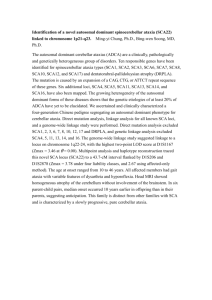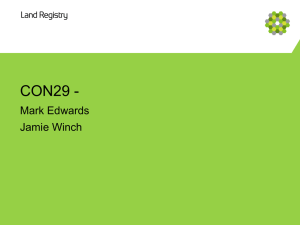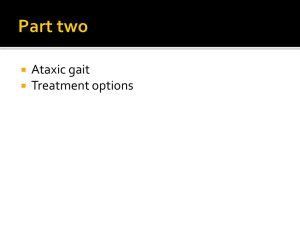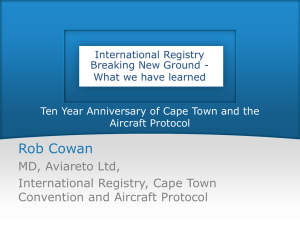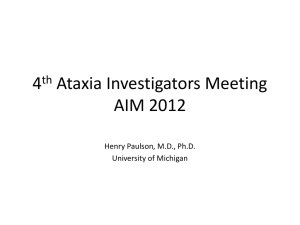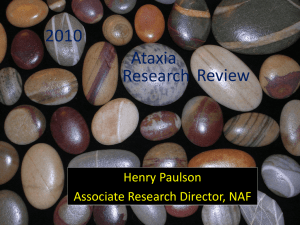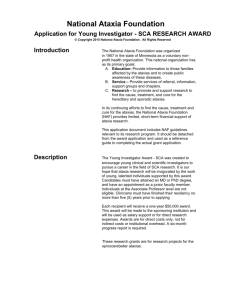National Ataxia Registry - National Ataxia Foundation
advertisement
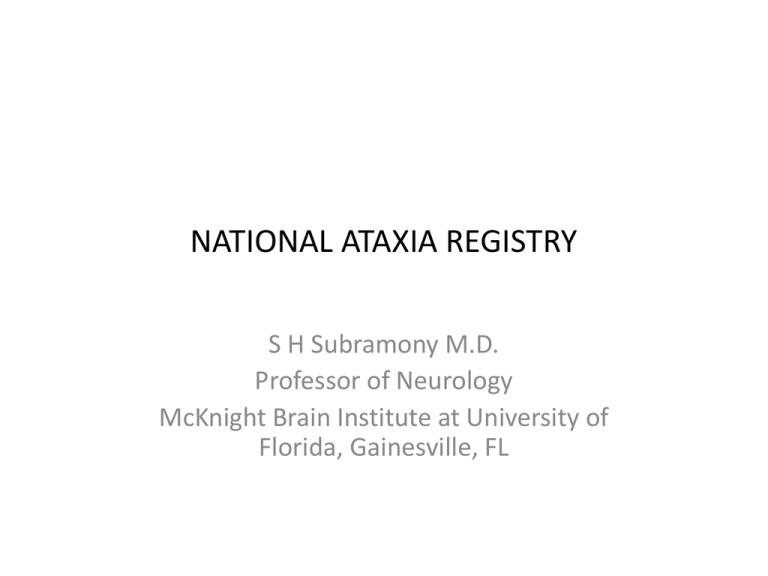
NATIONAL ATAXIA REGISTRY S H Subramony M.D. Professor of Neurology McKnight Brain Institute at University of Florida, Gainesville, FL What is the National Ataxia Registry? • Database that collects basic information on patients with “degenerative” ataxia • “Contact” registry: contact information and diagnosis • “Curated”: we confirm the diagnosis as much as possible • What type of patients can participate? – Patients with ataxia not caused by an obvious and known disease like MS, strokes, tumors, infections etc – Patients with inherited and sporadic ataxias of all types Purpose of the registry • Facilitate clinical research including drug trials in the field of ataxias • Bring appropriate research groups in touch with the right group of patients • Caveats – Registry participation does not guarantee participation in a drug trial – You do not commit to participation in any trial or study – Especially useful in the field of rare diseases Who can participate • Inherited ataxias – Dominant (SCA 1,2,3,5,6,7,8,10,12,13,14,17,DRPLA, other uncertain types) – Recessive (FA, AOA, POLG/MIRAS, AT, other types) – Mitochondrial, X-linked including FXTAS • Sporadic ataxia (MSA, OPCA, idiopathic ataxia) • Congenital ataxia • Any other degenerative ataxias including gluten ataxia, GAD ataxia • All inclusive Registry process • Visit the web site (directly or through the NAF web site) www.nationalataxiaregistry.org • Click on new user log in on home page • Enter essential contact information on page 2 • Enter and confirm e mail address, choose a password and a security question on page 3 • Print informed consent from page 4 • Registry personnel will contact you for telephonic consent before activating the account • Once activated you will be able to log back and enter diagnostic details and basic information on “functional stage” KEEP PASSWORD/SECURITY QUESTION WRITTEN IN SECURE PLACE SEND COPY OF KEY DIAGNOSTIC DOCUMENT WITH CONSENT National Ataxia Registry National Ataxia Registry – page 1 National Ataxia Registry – page 2 Clinical Information Page Clinical Information Page 2 Clinical Information page 3 Some key points • Secure link and encrypted transmission (industry standard/SSL mechanism); encrypted passwords using one way mechanism (Hash) • Supported by the NAF • Software creation by a dedicated volunteer group from HP-EDS with previous experience with the FARA registry • Participation entirely voluntary • Can withdraw your participation by contacting registry personnel Process for data sharing • Access to data only by registry PI and designated co-workers • Interested researchers will submit IRB approved protocol with request for specific patient groups • Second review of the scientific and ethical merits by the advisory committee • Researcher-patient contact Current status • • • • • In NAR database Contacted Awaiting ICF Active Complete 816 372 135 65 168 Current status • • • • • • • • SCA 3 SCA 6 FA SCA 2 SCA 1 Sporadic Unknown types Others: 43 41 34 26 26 33 80 SCA7, SCA 14, SCA 17, AOA 2, DRPLA, congenital Stumbling blocks • Telephonic consent process required by UF IRB – Time between initial contact and consent process – Requirement for multiple phone/e mail communications – Loss of passwords – Loss of follow through and failure of completion • • • • Personnel turnover Occasional site malfunction Computer issues (unable to download etc) No internet access The Informed Consent Process • Both national and local regulations • IRB requirements – Language – Who can do it – Personal contact • Web based consent has been used by many registries • Dialog with UF IRB in progress • Goal: web based consent and one step registration Acknowledgements Tommy Zhu, the man down-under Bill Hartnett Marty Ohmann Thanks also to… • • • • Phuong Deleyrolle Sue Hagen Tiara Ong T.Ashizawa
